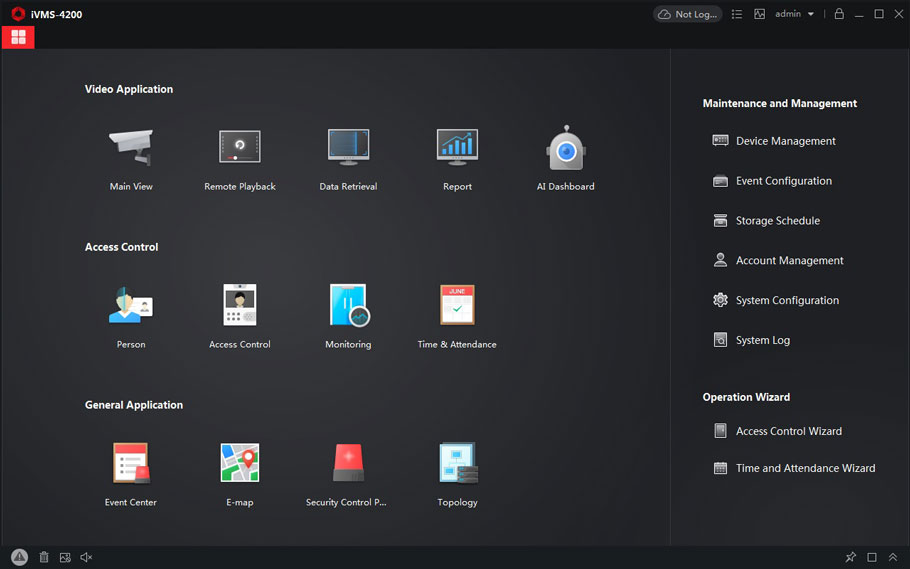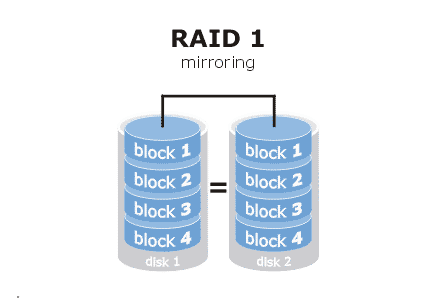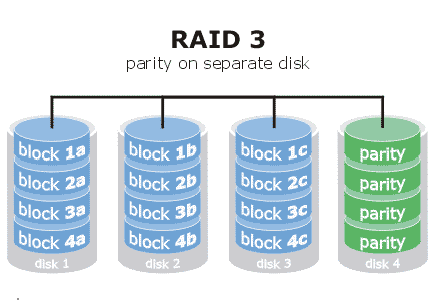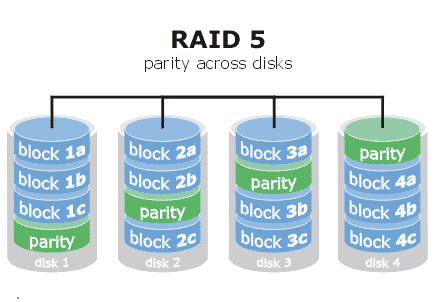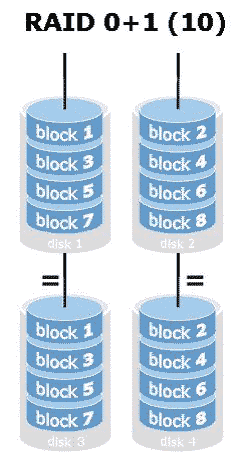RAID Introduction
RAID is a technology that is used to increase the performance and/or reliability of data storage. The abbreviation stands for Redundant Array of Inexpensive Disks. A RAID system consists of two or more disks working in parallel. These disks can be hard discs but there is a trend to also use the technology for solid state drives. There are different RAID levels, each optimized for a specific situation. These are not standardized by an industry group or standardization committee.
Load more : How to view an NVR remote viewing
Below is an overview of the most popular RAID levels:
RAID level 0 – Striping
In a RAID 0 system data are split up in blocks that get written across all the drives in the array. By using multiple disks (at least 2) at the same time, this offers superior I/O performance. This performance can be enhanced further by using multiple controllers, ideally one controller per disk.
Advantages
- RAID 0 offers great performance, both in read and write operations. There is no overhead caused by parity controls.
- All storage capacity is used, there is no disk overhead.
- The technology is easy to implement.
Disadvantages
RAID 0 is not fault-tolerant. If one disk fails, all data in the RAID 0 array are lost. It should not be used on mission-critical systems.
Ideal use
RAID 0 is ideal for non-critical storage of data that have to be read/written at a high speed, such as on a Photoshop image retouching station.
RAID level 1 – Mirroring
Data are stored twice by writing them to both the data disk (or set of data disks) and a mirror disk (or set of disks) . If a disk fails, the controller uses either the data drive or the mirror drive for data recovery and continues operation. You need at least 2 disks for a RAID 1 array.
RAID 1 systems are often combined with RAID 0 to improve performance. Such a system is sometimes referred to by the combined number: a RAID 10 system.
Advantages
- RAID 1 offers excellent read speed and a write-speed that is comparable to that of a single disk.
- In case a disk fails, data do not have to be rebuild, they just have to be copied to the replacement disk.
- RAID 1 is a very simple technology.
Disadvantages
- The main disadvantage is that the effective storage capacity is only half of the total disk capacity because all data get written twice.
- Software RAID 1 solutions do not always allow a hot swap of a failed disk (meaning it cannot be replaced while the server keeps running). Ideally a hardware controller is used.
Ideal use
RAID-1 is ideal for mission critical storage, for instance for accounting systems. It is also suitable for small servers in which only two disks will be used.
RAID level 3
On RAID 3 systems, data blocks are subdivided (striped) and written in parallel on two or more drives. An additional drive stores parity information. You need at least 3 disks for a RAID 3 array.
Since parity is used, a RAID 3 stripe set can withstand a single disk failure without losing data or access to data.
Advantages
- RAID-3 provides high throughput (both read and write) for large data transfers.
- Disk failures do not significantly slow down throughput.
Disadvantages
- This technology is fairly complex and too resource intensive to be done in software.
- Performance is slower for random, small I/O operations.
Ideal use
RAID 3 is not that common in prepress.
RAID level 5
RAID 5 is the most common secure RAID level. It is similar to RAID-3 except that data are transferred to disks by independent read and write operations (not in parallel). The data chunks that are written are also larger. Instead of a dedicated parity disk, parity information is spread across all the drives. You need at least 3 disks for a RAID 5 array.
A RAID 5 array can withstand a single disk failure without losing data or access to data. Although RAID 5 can be achieved in software, a hardware controller is recommended. Often extra cache memory is used on these controllers to improve the write performance.
Advantages
Read data transactions are very fast while write data transaction are somewhat slower (due to the parity that has to be calculated).
Disadvantages
- Disk failures have an effect on throughput, although this is still acceptable.
- Like RAID 3, this is complex technology.
Ideal use
RAID 5 is a good all-round system that combines efficient storage with excellent security and decent performance. It is ideal for file and application servers.
RAID level 10 – Combining RAID 0 & RAID 1
RAID 10 combines the advantages (and disadvantages) of RAID 0 and RAID 1 in one single system. It provides security by mirroring all data on a secondary set of disks (disk 3 and 4 in the drawing below) while using striping across each set of disks to speed up data transfers.
What about RAID levels 2, 4, 6 and 7?
These levels do exist but are not that common, at least not in prepress environments. This is just a simple introduction to RAID-system. You can find more in-depth information on the pages of wikipedia or ACNC.
RAID is no substitute for back-up!
All RAID levels except RAID 0 offer protection from a single drive failure. A RAID 6 system even survives 2 disks dying simultaneously. For complete security you do still need to back-up the data from a RAID system.
- That back-up will come in handy if all drives fail simultaneously because of a power spike.
- It is a safeguard if the storage system gets stolen.
- Back-ups can be kept off-site at a different location. This can come in handy if a natural disaster or fire destroys your workplace.
- The most important reason to back-up multiple generations of data is user error. If someone accidentally deletes some important data and this goes unnoticed for several hours, days or weeks, a good set of back-ups ensure you can still retrieve those files.
